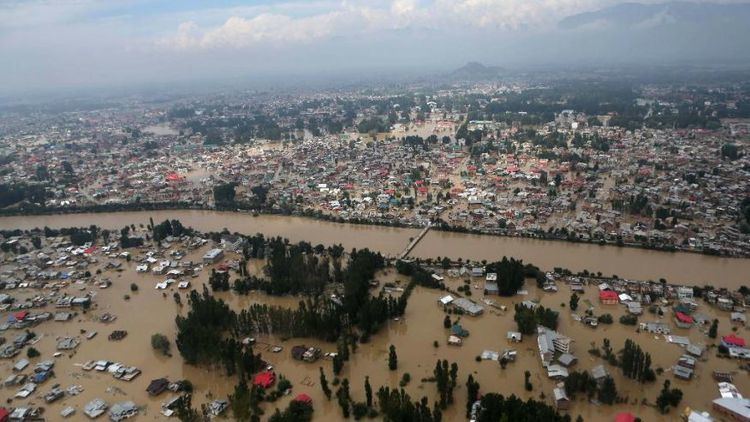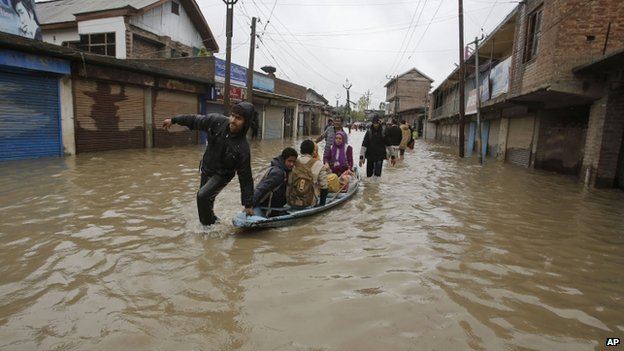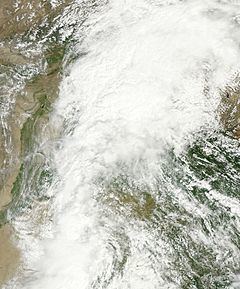Date 2–26 September 2014 | ||
 | ||
Property damage 2,550 villages affected80,000 people evacuated Similar 2010 Pakistan floods, 2015 South Indian floods, 2013 North India floods, 2014 Southeast Europe fl, 2014 Malin landslide | ||
In September 2014, the Kashmir region suffered disastrous floods across many of its districts caused by torrential rainfall. The Indian administrated Jammu and Kashmir, as well as Pakistan administered Azad Kashmir, Gilgit-Baltistan and Punjab were affected by these floods. By 24 September 2014, nearly 277 people in India and about 280 people in Pakistan had died due to the floods.
Contents

Origin

The Jammu and Kashmir state and adjoining areas received heavy rainfall from 2 September 2014 onwards, during last stage of monsoon in India. This triggered flooding and landslides in India and the adjoining areas of Pakistan. On 5 September, the Jhelum River in Srinagar was reported to be flowing at 22.40 feet (6.83 m) which was 4.40 feet (1.34 m) above the danger mark and at 33 feet (10 m) at Sangam in Anantnag district above the danger mark. The discharge rate in the river was recorded as 70000 m3/s against the normal discharge of 25000 m3/s. The Chenab River was also reported to flow above the danger mark by which hundreds of villages were affected in Pakistan. These rivers flooded into the streets causing heavy casualties and loss of property.
India

According to the Home Ministry of India, several thousand villages across the state had been hit and 390 villages had been completely submerged. In actual figures 2600 villages were reported to be affected in Jammu and Kashmir, out of which 390 villages in Kashmir were completely submerged. 1225 villages were partially affected and 1000 villages were affected in Jammu Division Many parts of Srinagar, including the Border Security Force (BSF) HQ in Sanant Nagar & Army cantonment in Badam Bagh, were inundated, and vital roads were submerged, by the floods.
Pakistan

The strongest post monsoon storm ever recorded in Pakistan's recorded history took place on 3 September on a very low pressure system which started to affect parts of Jammu and Kashmir and northeast Pakistani districts of Sialkot, Lahore, Narowal, Gujrat, Mandi Bahauddin, Gujranwala, Hafizabad, Sheikhupura. By fourth, the rains became more widespread as the northern Punjab, Pakistan, Azad Kashmir and Khyber Pakhtunkhwa including the twin cities of Rawalpindi/Islamabad, Mangla, Rawalakot, Kotli and Jhelum. The heaviest amounts of rainfall however were recorded on 4 and 5 September as several weather stations broke their 24-hour, 48-hour and total monthly rainfall records for the month of September.
The chief amounts of total rainfall (in mm) as a result of this spell is as follows: (recorded between 3 and 5 September)
Live events
On 8 September, in many parts of Srinagar's neighbourhood, the water was about 12 feet (3.7 m) deep, submerging entire houses. Stranded residents left their homes to move in with friends or relatives in safer areas. The death toll till 10 September had crossed 190 in Kashmir valley and areas affected by the floods were mostly districts in South Kashmir.
India
In Srinagar, most of the city areas were submerged under water. The river Jhelum spilled over submerging Sonwar Bagh, Shivpora, Batwara, Pandrathan, LalChowk, Rajbagh, Jawahar Nagar, Gogji Bagh and Wazir Bagh neighbourhoods of city. The first and the second storey of the houses and hotels in Rajbagh that were packed with tourists were submerged. According to Omar Abdullah, the Chief Minister of Jammu and Kashmir then, boats had been brought from Delhi to help with evacuations, and the air force had begun rescue operations in the city.
50 bridges were reported to have been damaged across the state. The preliminary assessment of damages to property was estimated between INR 5000 cr to INR 6000 cr. The state government requested the central government for 25,000 tents and 40,000,000 blankets for the affected people. There was a total estimated loss of 1 trillion to Kashmir division alone.
In the Jammu Division, landslides triggered by heavy rainfall had damaged roads, dozens of bridges, buildings and crops. Vehicular traffic had been stopped on the Jammu-Pathankot highway. Katra-bound trains were halted. Haj flights scheduled up to 12 September were postponed. The Jammu-Pathankot national highway was opened on 8 September, after the water level receded. Srinagar-Leh Highway reopened for traffic on 9 September. The Prime Minister of India Narendra Modi called it a "national calamity".
Pakistan
Flow of destruction as flood water entered Multan villages. While the Trimmu Head works was saved from the peak flood discharge, more than 350 villages in Jhang District were flooded due to the breaches made at two places in Athari Hazari dyke, leaving trail of destruction behind. As the floodwater moved further south, water level started increasing at Panjnad and had reached 116,000 cusecs, flooding areas in Mittan Kot and 300 villages in Multan District. National Disaster Management Authority (NDMA) said that 257 people had been killed and more than 1.1 million were affected by the floods. According to reports, the Trimmu Head works, safely discharged 650,000 cusecs of water resulting in the water levels to recede. Three people were reported killed in Jhang and nine in Chiniot. Due to massive rain in Jammu and Kashmir as well as Azad Kashmir and in Pakistani Punjab constituted flood situation in River Chenab and River Jhelum.
India
Home Secretary of India Anil Goswami said 82 aircraft and helicopters, 10 battalions of Border Security Force,329 columns of Indian Army and 300 boats were used in the rescue operations. According to home secretary, 10 VSAT systems were air lifted to restore critical telecom towers and a satellite link from Bardula had been provided for crucial communication. The Indian Army showing their ingenuity used some old fashioned Indian Juggar and converted their trucks to mobile charging platforms for the people to charge their mobile phones. Two IL 76, One C-130J and one AN 32 aircraft carried a total of 50 tonnes of supplies including food, water and medicines. 300 boats were dispatched to South Kashmir for excavation of people from submerged areas. Armed Forces including Border Security Force (B.S.F) and National Disaster Response Force (NDRF) rescued over 200,000 people from different regions of Jammu and Kashmir. Bharat Sanchar Nigam Limited (BSNL) launched an operation on a war-footing with Indian Army and Indian Air Force (IAF) to restore mobile services through satellite network and the telecom network.
Home Ministry had been sent to Srinagar to monitor rescue operations. The government also set up control rooms in Delhi and asked people to approach it with details of their trapped families.
Lt. General Subrata Saha of the Indian Army said that the rescue efforts of the Army would not have been possible without the assistance and efforts of the local youth. Every second or third boat of the Army went to the local volunteers. "The Army salutes the efforts put by the youth of the Valley," he said. "If not for these local youths, who have guided us to reach the places, I cannot say how we would have been able to accomplish the mission." The daily Rising Kashmir quoted an Indian Army trooper saying that, while the Army was doing its bit to rescue the people, it could not match the job done by the locals. The trooper further stated that the Indian news channels focused on covering the Army more than the plight of the victims, which was causing resentment among the local people. The total of about 200,000 people were rescued, including 87,000 from Srinagar city.
Pakistan
The Pakistani Army and the Pakistani Air Force carried out most of the rescue operations like dropping food packets, packaged drinking water and winching stranded people from their roof tops using helicopters,etc. The United Jihad Council, which includes the militant groups of Al-Qaeda, Lashkar-e-Taiba (LeT) and Jaish-e-Mohammed (JeM), said that they would suspend all the operations against the Indian army in Kashmir and help the victims even though this was brushed aside as a gimmick.
Relief
Prime Minister of India did not allow the foreign aid to Kashmir. The Prime Minister of India, Narendra Modi, offered an assistance of ₹745 crore (US$110 million) to the state government, this was in addition to ₹1,100 crore (US$160 million) already earmarked for the disaster. Chief Minister of Maharashtra and Chief Minister of Telangana announced an aid of ₹10 crore (US$1.5 million) each from the chief minister's relief fund for the rescue and relief for Jammu and Kashmir flood victims, in addition to that Government of Telangana has also announced to send 50 water purifiers worth ₹2.5 crore (US$370,000) for safe drinking water for flood affected areas. Also, Madhya Pradesh, Tamil Nadu, Gujarat and Andhra Pradesh, announced an assistance of ₹5 crore (US$740,000) each and appealed to the people to come forward and help those in need.
Jammu and Kashmir Chief Minister Omar Abdullah announced relief package for those affected by the floods. It included Rs.200 crore assistance for Jammu region and the valley and Rs.3.5 lakh for the kin of those who lost their lives in the disaster which includes Rs.2 lakh announced by Prime Minister Narendra Modi. Omar also announced financial assistance of Rs. 75,000 as initial installment for those who lost their homes. Free food supply will be supplied to the affected for six months which includes 50 kg of rice.
The United India Insurance Company also presented a cheque of Rs. 1 crore to Jammu and Kashmir Chief Minister Omar Abdullah for flood-affected people of the State. People from unaffected areas of Kashmir set up relief camps, collected and distributed relief among flood-ravaged people of Srinagar city. Jammu and Kashmir government ministers have called it the equivalent of Hurricane Katrina in Kashmir. Further, to help the people of Jammu & Kashmir, to build back all the damaged infrastructure, a student-professor duo, Saqib Gulzar and A. R. Dar at NIT Srinagar came up with Preliminary Guidelines for Repair, Restoration, Retrofitting & Rebuilding of Building Structures in Flood Affected Areas of Jammu & Kashmir. These guidelines were well received by the people of Jammu and Kashmir and helped them in building back the infrastructure damaged by the floods.
